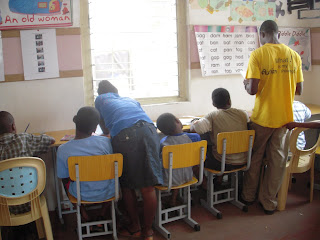
As the air cools and leaves begin to change their color in the US, the sun begins to burn brighter here in Ghana. Similar to the US, September not only begins a change in weather, it also signifies the reopening of a new school year. During the summer months, AACT had about 15 students who regularly attended the center with just about one caregiver for every child. Many of the other students traveled with their families or stayed home with other siblings on vacation. Over the past few weeks, all of these students have returned. Now a typical day at AACT has about 25 students, being taught by 12 caregivers, 3 directors, and a few volunteers. Not including the daily visitors, there are over 40 moving bodies in the center on a regular basis, at least half of whom have autism.

Due to increased attendance, it became necessary to find more effective ways to keep groups of students engaged. With support from Auntie Baaba and help from two new volunteers, we put together a more structured morning routine for the middle classroom. We choose this room to focus on first, because they typically have the most students with the least amount of caregivers. The routine involves the students identifying “who is here today” by moving pictures of themselves to the appropriate area, going through the day of the week, month, year, and then identifying the weather. So far, it seems to be working well!

There has been a lot of other excitement over the past few weeks. On September 8th, a television series called Impact Africa came to film an episode at AACT. This included footage of the students activities and interviews with Auntie Serwah and I. Last week, the Rotary Club came to present a donation to the center. There were over 25 members who came for the ceremony. It was a great opportunity for them to learn more about children with autism and the services provided at AACT.

On top of all of this, I have been continuing correspondence with a variety of others. Caroline Pongo, the creator of a local educational puppet theater, came to the center last Thursday. Her and I discussed getting the students involved with a puppet making workshop, as well as planning a performance at the center. Stacey Reynolds, an Occupational Therapy professor at Virginia Commonwealth University has agreed to include AACT on their annual service trip next May. This is especially exciting because there are currently no Occupational Therapists in Ghana. This coming Monday, I have a meeting with Nana Ocran, the Director of Education at the Ghana National Museum, to begin setting up educational programs at the museum modified for children with autism.
In regards to administrative tasks, I have been involved with developing job descriptions and creating an employee code of conduct. These will be compiled into an employee handbook and be available in the future for new employees. As volunteers come and go, we have been asking for their feedback as well, in order to continuously improve the current volunteer handbook. The point of all of this is documentation. Keeping records, putting job rules and regulations on paper, tracking the number of volunteers in a given time period, etc. It all helps to strengthen an organization’s permanence.

Last but not least, the Caregiver Challenge, a fundraiser started about a week and a half ago, has already raise 130GHc (about equal to about $90 US Dollars)! Auntie Serwah has created a bank account that is specifically for donations. The goal is to not touch this money until there is enough to build, buy, or rent an additional, desperately needed, facility.
All in all, things are progressing! And as much as I miss the beautiful fall weather, the warm sun doesn’t feel too bad. Thanks again for reading.
Until next time,
Casey



